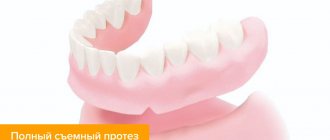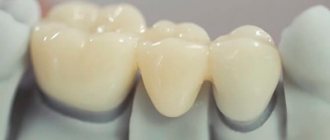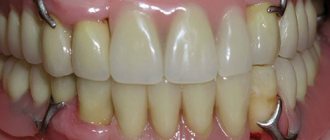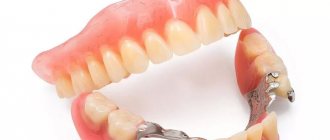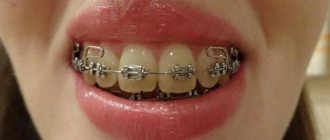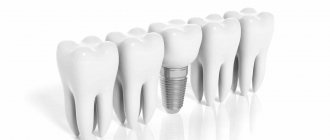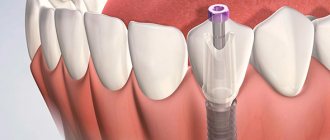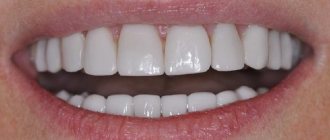Dental implants or bridges are used to restore lost teeth. Both options are functional and aesthetic. However, there are significant differences between them. To fix the bridge, the units adjacent to the defect are depulped and ground down. Due to improper load distribution, they gradually collapse and the jawbone atrophies. For an implant, these problems are eliminated. It is implanted into the jaw without the use of healthy teeth and prevents bone loss. When choosing a method, the patient should focus not only on finances, but also on long-term results.
In the photo - a dental bridge (left) and an implant (right)
What are bridges and dental implants?
A bridge is a permanent dental prosthesis consisting of crowns welded together, the outermost of which are fixed on previously ground living teeth. Used to restore 1-4 missing units in a row. The number of support units is always two. Bridges are usually created from the following materials: metal ceramics, zirconium dioxide. We install only metal-free structures.
Dental implants are artificial analogs of tooth roots that act as supports for individual crowns or dentures. Manufactured from medical titanium, biocompatible with oral tissues. Indicated for single, partial and complete edentia. They are implanted into the jaw using the following methods: classic, express, simultaneously with tooth extraction. They fully restore the functions and aesthetics of the dentition.
Options for fixing a bridge on implants for 2, 3, 4 and 5 teeth
Artificial teeth fully participate in chewing food and are also used in articulation. The entire load from the prosthesis must be evenly transferred to the titanium roots. The service life of the implants and the orthopedic structure itself depends on this. Correct distribution of the entire load stops the thinning of the alveolar ridge, eliminates the reduction of gum level, which together helps to preserve the aesthetics of the dentition. Fixing a bridge on 2 implants is the right decision, but doctors recommend installing a ratio of at least 1:2, which means one titanium rod for two artificial crowns.
Bridge on implants for 2 teeth
If two units are missing, it is recommended to restore each lost tooth separately. The patient has 2 implants installed, each of which has a separate crown attached to it, which will make it easier to repair the crowns in the future, if necessary. The method provides aesthetics and eliminates the consequences of losing teeth. A bridge on implants for 2 lost teeth is not effective; two combined crowns will make it difficult to care for the structure and repair it if necessary.
Bridge on implants for 3 teeth
If a defect in the dentition is 3 units long, a single restoration of three implants can be performed. The second option is to install a bridge on two implants - on both sides of the defect. A bridge on 2 implants for 3 teeth is fixed using special cement or using screw fixation through the chewing surface of the crown. The marginal crowns are firmly attached to titanium pins, while the central crown remains suspended.
Bridge on implants for 4 teeth
If 4 units are missing, it is advisable to install 3 implants. It is possible to fix a bridge on 2 implants for 4 teeth, but the aesthetics and functionality of the structure will suffer. Without properly distributed load, the area under the two hinged crowns will sag over time as a result of atrophy. The risk of prosthesis breakage increases with increasing load on its central part.
Bridge on implants for 5 teeth or more
Prosthetics with a bridge on implants is possible for 5 teeth, as well as for more significant defects in a row. If 5 units are missing, the patient is recommended to have at least 3 implants installed. If the location of artificial roots is correctly calculated, this amount is sufficient to evenly distribute the load. Longer defects are repaired with the number of titanium roots equal to half the number of bridge crowns.
Pros of the methods
If we compare both options, then both the bridge and the implant are non-removable structures, matched to the color and shape of the patient’s natural teeth, and restore the functionality of the dentition. However, each method has individual advantages.
Pros of bridges on your teeth:
- shortened treatment periods;
- minimum contraindications;
- affordable price.
Advantages of implants:
- functional, aesthetic;
- allow you to restore any number of lost units;
- suitable for restoring terminal defects of the dentition;
- prosthetics with single crowns, bridges and complete dentures;
- have increased stability;
- distribute the load evenly, protect the jaw bone from resorption;
- crown replacement is performed without removing the titanium root;
- have a lifetime service life (for Nobel Biocare models).
The main advantage of implants compared to classic bridges is that to install the prosthesis, it is not necessary to grind down the units adjacent to the defect.
Pros of installing an implant
During implantation, the artificial root serves as a support for the crown. Most often, high-strength titanium is used, which ensures complete inertness. This eliminates the risk of rejection and allergic reactions. Implants fully perform the functions of teeth: they restore chewing efficiency, are responsible for uniform load on the jaw bone, and maintain the shape of the gums. The appearance of an artificial neighbor does not affect the units located nearby, since titanium structures are implanted into the jaw bone, after which a crown or bridge is installed on them.
- reliability, strength, durability of structures;
- over time, bone tissue does not atrophy;
- no need to remove pulp from adjacent units;
- With proper care they can last a lifetime.
- relatively high cost;
- the presence of contraindications (diseases of the circulatory system, oncology, HIV, decompensated diabetes mellitus, diseases of the immune and endocrine systems, scleroderma, lupus erythematosus, etc.);
Contraindications
Among the limitations to classical bridge prosthetics:
- diseases of periodontal tissues (periodontal disease, periodontitis);
- serious malocclusion;
- pathological abrasion of enamel;
- inflammation of the oral cavity;
- osteoporosis and other diseases of the jaw bone tissue.
Dental implants are contraindicated in the following cases:
- high blood pressure;
- blood diseases;
- malignant neoplasms;
- diseases of the cardiovascular, endocrine, nervous systems;
- uncompensated diabetes mellitus;
- mental disorders;
- HIV AIDS;
- tuberculosis;
- infectious processes in the body;
- gum disease;
- age up to 16 years.
Implantation is also not performed in case of relative contraindications - lactation and pregnancy in women, if the patient has bad habits (smoking, alcohol abuse, drug use).
Caring for implant bridges
A brush, paste, rinse and irrigator are the main tools to achieve excellent oral hygiene every day. After each meal, you should rinse your mouth to remove food debris with water or mouthwash. After implantation, the gums become less sensitive, so you should use super-floss carefully.
It is necessary to visit the doctor once every six months for a preventive examination. It is also advisable to carry out comprehensive professional cleaning at least once a year.
Author:
Possible complications
After installing the bridge, the patient may encounter the following problems:
- sensation of a foreign body in the mouth in the first 5-7 days;
- pain (if you have this symptom, we recommend that you consult a doctor);
- food getting under the prosthesis (in case of improper fixation of the structure);
- peeling off crowns (occurs with bruxism in a patient);
- exposure of the neck of the supporting unit.
Complications after implantation occur in less than 5% of clinical cases. Among them:
- bleeding (occurs when a patient has a blood clotting disorder);
- pain (in the first 5-7 days this is a normal reaction to surgery, after this period it is a reason to consult a doctor);
- seam divergence;
- perforation of the bottom of the maxillary sinus;
- damage to the mandibular nerve (accompanied by numbness);
- peri-implantitis (inflammation of the gum tissue around the implant);
- design rejection.
Comparison of methods by characteristics
Prosthetics on implants and a bridge have a number of fundamental differences. Each technique has advantages and disadvantages. The doctor chooses the technology after assessing all factors.
Advantages
Implants are able to withstand increased chewing loads, distributing them evenly across the jaw, due to this they are not destroyed during operation. Unlike classic bridges on your teeth, which require systematic re-cementing, implants are implanted once and for life.
In the case of classic bridges, the load falls on the supporting teeth. This can lead to their gradual destruction and removal. The size of the prosthesis will increase until there are no units left to act as support. At the site of the defect, bone tissue atrophy will continue. Implantation solves this problem.
Flaws
The main disadvantages of implantation include:
- high cost - but considering that implants are installed for life, the costs are justified;
- many contraindications - currently the list of contraindications has decreased, new technologies have been developed;
- treatment period (if a two-stage protocol with delayed loading is used, accompanied by osteoplastic intervention) - one-stage technologies will allow you to restore the dentition in 1-3 days.
Installation of a bridge requires the preparation of two supports. It’s sad if you have to injure healthy units. Due to the uneven redistribution of mechanical load, bone tissue atrophy accelerates, the contour of the gum changes and sags. A gap appears between the bridge and the gum where bacterial plaque and food particles accumulate. Not all prosthetic structures are subject to repair and relocation. Teeth under crowns are subject to secondary caries, which will lead to rapid tissue destruction and an increase in the length of the defect.
Contraindications
Implantation is a surgical procedure with some contraindications. But unlike the classic bridge, a number of protocols can be used for serious periodontal pathologies, problems with bite, occlusion, and a complicated medical history.
Both methods are contraindicated in:
- inflammatory process of the oral cavity;
- infections in the acute stage;
- chronic diseases in the stage of decompensation.
Absolute contraindications to implantation include oncology and severe bleeding disorders. A bridge is not installed in cases of terminal and long-term defects (loss of 4 units in a row or more), malocclusion pathologies, or low height of dental crowns.
Possible complications
The survival rate of implant structures is 98-99.9%. But in rare cases, complications are possible - peri-implantitis (inflammation of the tissue around the implant), rejection of the artificial root. Engraftment of the implant structure requires the professionalism of the doctor and the patient’s compliance with the instructions in the postoperative period and beyond.
After installing a bridge structure, the neck of the supporting teeth may be exposed due to subsidence of the gums. With bruxism, restorations may fall out of the prosthesis. Due to improper redistribution of mechanical load, the bridge wears out faster, the supports under it become loose and shift.
Life time
The manufacturer indicates the service life of the implant is 20 years or more. With proper care and regular dental care, an artificial root will last a lifetime . An orthopedic structure installed on implants requires replacement no earlier than after 10-25 years (structures made of zirconium dioxide - 20 years and above).
The service life of a dental bridge, due to rapid wear due to bone subsidence, averages 6-10 years (depending on the material).
Price
When considering the question of what is cheaper, a bridge or an implant, we focus on the long term.
- Installing a metal-ceramic bridge of three artificial crowns costs 20-25 thousand rubles. per unit , zirconium - 40-60 thousand rubles per unit . Preparation is paid separately - depulpation of 2 support units costs 10-18 thousand rubles.
- Installation of a classic ROOTT implant on a turnkey basis costs 28 thousand rubles. , plus a metal-ceramic crown 28 thousand rubles. (zirconium - 35 thousand).
The final price of prosthetics is not too different. Considering that the bridge will have to be re-cemented every 6-10 years, which may require treatment and restoration of supporting units, implantation will allow for a more cost-effective restoration of the dentition.
Implants are a profitable solution
Classic bridge prosthetics is less expensive than implantation. However, if you take into account the costs of depulping the supporting units before installing a bridge and the need to replace the prosthesis every 7 years (in the best case scenario), implants are a profitable solution. Titanium roots do not destroy healthy teeth and have a lifetime service life, and zirconium dioxide crowns will not require replacement for at least 20 years.
Levin Dmitry Valerievich
Chief physician, Ph.D.
Top 10 reasons why you should choose an implant over a dental bridge
1. Installation of implants is painless
The installation of a dental implant is painless, since local anesthesia is used, and the procedure takes an average of 20 minutes, which allows for minimal tissue trauma, shortening the rehabilitation period and the tissue healing process in the next few days.
2. Minimal surgical intervention
The installation of a dental implant involves a minimal amount of tissue, so the patient does not need to spend a long time in the dentist’s chair. The procedure itself for implanting one dental unit can take, depending on the complexity, from 15 minutes (when restoring the front teeth) to 40 minutes (when an artificial root is implanted in place of the lost outer chewing teeth). In modern dentistry, several implantation options are presented, including one-step and one-stage procedures. They allow you to avoid repeated surgical procedures for prosthetics and gum formation.
3. Minimal risk Installation of a high-quality dental implant is successful in 98-99% of cases. Much of the success is undoubtedly related to the qualifications of the doctor, as well as the quality of the materials used and the brand of the implant. However, it is important for the patient to remember that the service life of the artificial root directly depends on careful care and respect for one’s health. In the long term, the implant can last more than 20 years. For comparison, it can be noted that when restoring teeth with a fixed bridge supported by one’s own teeth, the risk of loosening and infection is greater, and their service life is limited to 4-8 years.
4. The implant preserves healthy teeth
Installing a dental implant allows you to save adjacent teeth from grinding, preparation, nerve removal and root extraction. After a long period of using implants, neighboring teeth do not experience overload, as when wearing a dental bridge, so they are protected from loosening, injury and loss.
5. Preservation of bone tissue After a tooth is removed, in the area of the gap formed, the bone tissue is no longer supplied with nutrients and becomes smaller in volume. The gum level noticeably sags up to 1 mm per year, which ultimately can cause weakening of the ligamentous apparatus of other teeth. The implant puts a natural load on the bone tissue area, stimulates further functioning and prevents the death of microcapillaries and blood vessels.
6. The implant imitates a natural tooth
A dental implant more naturally restores a lost tooth in terms of functionality, as it is anchored inside the bone, like your own tooth root. The crown is also closer in appearance and can also withstand greater loads than removable dentures.
7. Reliable and Safe Solution With dental implants, chewing forces are better supported and balanced across the entire dentition, reducing stress on individual units and the jaw joint.
Successful installation is possible by choosing a higher quality implant or a proven, reliable brand. Top manufacturers include implants Alpha-bio, Nobel Biocar, Straumann and others. However, the healing rate and duration of service may vary depending on your health status. Smoking, diabetes, gum inflammation, chronic blood and bone diseases greatly affect the results of the operation. They can reduce survival rates by up to 90%. This is because additional treatment must be performed before any attempt to place an implant.
8. More durable results Compared to other types of dentures, a dental implant has a longer service life - more than 20 years. Removable dentures, as a rule, are replaced after 3-5 years, clasp dentures can last about 6 years, dental bridges - up to 8. The reason for replacing the structure is most often bone resorption and changes in the contour of the gums.
To restore lost teeth, there is no need to replace each unit. If several teeth in a row are missing, then using a dental bridge supported by implants will effectively eliminate the defect. A dental bridge has high aesthetic values, a strong and durable frame. To prevent the development of atrophy, implants are selected to fill the gap with the most appropriate number of artificial supports. To restore chewing teeth, more massive implants with a larger diameter are required. The distance between them must be at least 3 mm. This way you can reduce the number of units used without losing quality. If a complete restoration of the jaw is planned using a bridge that includes 12-14 teeth, then 4-6 implants are used to fix it. The prosthetic technology (All-on 4 and All-on 6) has been clinically proven to be effective and preserves the gingival contour for more than 5 years of use, and the service life of the prosthesis is more than 10-20 years.
9. High level of comfort A dental implant is a solution that provides functional and aesthetic comfort. The places where the crown is attached are invisible and hidden by the gum. You need to care for an implant like you would your own tooth, while removable dentures are more demanding to care for and their use is noticeable to others.
10. High biocompatibility Modern implants are made from safe and biocompatible materials. The main metal for creating artificial roots is titanium, a durable, refractory and bioinert material. Impurities are used in minimal quantities, which reduces the risk of developing allergies. Spraying of minerals, a hydrophilic surface, and various types of threads allow the use of implants in complex clinical situations. The success rate of implantation surgery is 98% because the titanium dental implant is organically compatible with the human body.
What is better to put on the front teeth?
Implantation is the best option when restoring anterior units. This is due to increased demands on aesthetics. The bridge initially corresponds to them, but gradually, due to atrophy of the jaw bone, it sags, becomes mobile, and a gap appears between it and the gum. The implant, on the contrary, preserves the healthy appearance of the gums and compacts the surrounding bone tissue. As part of the classical installation method, the formation of the correct gingival contour is additionally carried out. Aesthetics do not deteriorate throughout the entire service life of the structure.
Advantages and disadvantages of a bridge on implants
Advantages:
- Healthy teeth are not affected;
- the life of your teeth is extended;
- there is a uniform distribution of chewing pressure;
- the process of jaw bone loss slows down;
- smooth aesthetic gingival margin;
- the structure is firmly fixed;
- end defects are eliminated;
- long service life (over 10 years).
Flaws:
- A 100% loss of bone tissue cannot be ruled out;
- the price is higher than that of classical prosthetics.
What to choose for a chewing tooth
In this case, the bridge and the implant have their own advantages and disadvantages. A bridge allows you to quickly restore the functionality of the dentition and cope with the chewing load normally. However, uneven distribution of pressure gradually leads to destruction and removal of supporting teeth.
The implant does not have a destructive effect on neighboring units; in all respects it is identical to a natural tooth. However, when installing a titanium root in the masticatory region, loading with a full-fledged prosthesis is not allowed until the artificial root has completely engrafted.
How many implants are needed to secure the prosthesis?
In case of complete absence of teeth, the minimum number of implants on which an orthopedic structure can be installed is 2 (all-on-2 protocol). True, this is only possible in the lower jaw, the bone of which is denser. The upper jaw bone is more porous, so fixation requires at least 4 implants (all-on-4). Installation of a minimum number of titanium “roots” is resorted to in cases where the patient’s budget is strictly limited.
However, if possible, it is better to install a larger number of titanium pins. The more there are, the more evenly the chewing load is distributed. Implant dentists believe that the ideal option is 1 implant for 2 missing teeth. In this case, the jawbone will receive sufficient stimulation to prevent its arthophia. If you use less, the atrophy will only slow down.
Clinical cases
- If one tooth is missing . When restoring a single defect, the condition of neighboring units is taken into account. If they are healthy, it is better to choose implantation, since bridge prosthetics involves depulping the supporting teeth. If they are already pulpless, you can install a bridge.
- If several teeth are missing in a row . The choice of method depends on the extent of the defect. A bridge can restore no more than four missing teeth in a row. Implants - any quantity. In this case, it is not necessary to place a separate rod in place of each lost unit. There are options to fix a smaller number of titanium supports and cover them with a bridge. A bridge on implants does not destroy healthy teeth, the load is distributed evenly, and jawbone loss is eliminated. Plus treatment is cheaper.
- End defect . If the outermost teeth in a row are lost, the only option is implantation, since to fix the bridge at the edges of the defect there must be two supports.
Advantages of metal-ceramic dental bridges
Among the main advantages:
- Strength. Metal-ceramic structures are very durable. This is due to the metal frame, which can withstand heavy loads even when replacing several missing teeth in a row.
- Low cost. This option is the most inexpensive of all modern solutions in this category.
- Possibility of installation on implants. Not every structure can be installed on an artificial root. Metal-ceramic bridges are excellent for implant prosthetics.
- This is an excellent option for prosthetics of chewing teeth.
What is better - dental implantation or bridge?
For a clear example of the strengths and weaknesses of both options, we provide a comparative table.
| Bridge | Implant | |
| Number of missing teeth | 1-4 | any quantity |
| Degree of mastication recovery | average | full identity to a natural tooth root |
| Aesthetics | average | high |
| Recovery time | up to 1 month | 4-6 months, with bone grafting - up to 1 year |
| Difficulty of installation | average | complex |
| Impact on adjacent teeth | subject to depulping and turning | are not used |
| Jaw bone loss | intense | absent |
| Reliability of fixation | mobility of supports is possible in case of diseases and inflammation of periodontal tissues | complete immobility |
| Difficulty of care | Difficulties arise when food gets under the prosthesis | does not require special care |
| Restrictions on food intake | increased load excluded | any load is allowed |
| Comfort while wearing | There is discomfort in the first days after installation | complete comfort |
| Life time | up to 7 years, depending on the condition of the support units | implant - for life, prosthesis - 15 years or more |
| Price | Average | High |
Our dentists recommend that patients do not delay the restoration of missing teeth. Without load, the jawbone begins to atrophy. The method of filling a gap in the dentition must be decided quickly. Each patient, taking into account his financial capabilities, makes his own decision - whether it will be a bridge or an implant.
Dental bridge or implant - which is better from an economic point of view?
The question of what to install (a bridge or an implant) in the event of the loss of one or more teeth is also relevant from a financial point of view. If you are on a limited budget and cannot afford to restore your teeth with implants, choose bridge structures. But keep in mind that classic bridges have a limited service life and need to be replaced over time. In the long term, implantation is a more profitable option for restoring teeth, despite the fact that implant-supported dentures are the most expensive. For example, one budget category implant and metal-ceramic crown will cost approximately 35,000 rubles: premium implants and prostheses can double this amount.
Classic bridges are cheaper: the price for a bridge of three crowns starts from 30,000 rubles. Designs made of ceramics and zirconium dioxide will cost more. For example, a ceramic bridge made using E-max technology costs from 60,000 rubles. Agree, this amount does not fit into the budget solution. In addition, the price of installing a classic bridge does not include the cost of preparing supporting teeth, while depulpation of one molar can cost more than 5,000 rubles. Add to this amount further expenses for replacing the prosthesis. As a result, the cost of a conventional bridge will be comparable to the cost of implantation.
How to install metal-ceramic dental bridges
Bridges are installed on the patient’s supporting teeth or on implants implanted into the bone. When installing on abutment teeth, the installation procedure takes place in several stages:
- Preparation of abutment teeth. To do this, they are ground down - excess tissue is removed so that the crown can be installed firmly, and the tooth does not look too bulky after that. Stump inlays can be installed.
- Taking impressions. Impressions are taken of both jaws to ensure the most correct anatomical shape.
- While the prosthesis is being manufactured in the dental laboratory, the patient may be fitted with a temporary prosthesis. This will provide comfort and protection to the prepared teeth.
- The prepared prosthesis is tried on; if all is well, it can be installed with permanent dental cement.
When installing on implants, the preparatory stage is the implantation of supporting implants. Then the technology is the same - taking impressions, making and installing a prosthesis.
